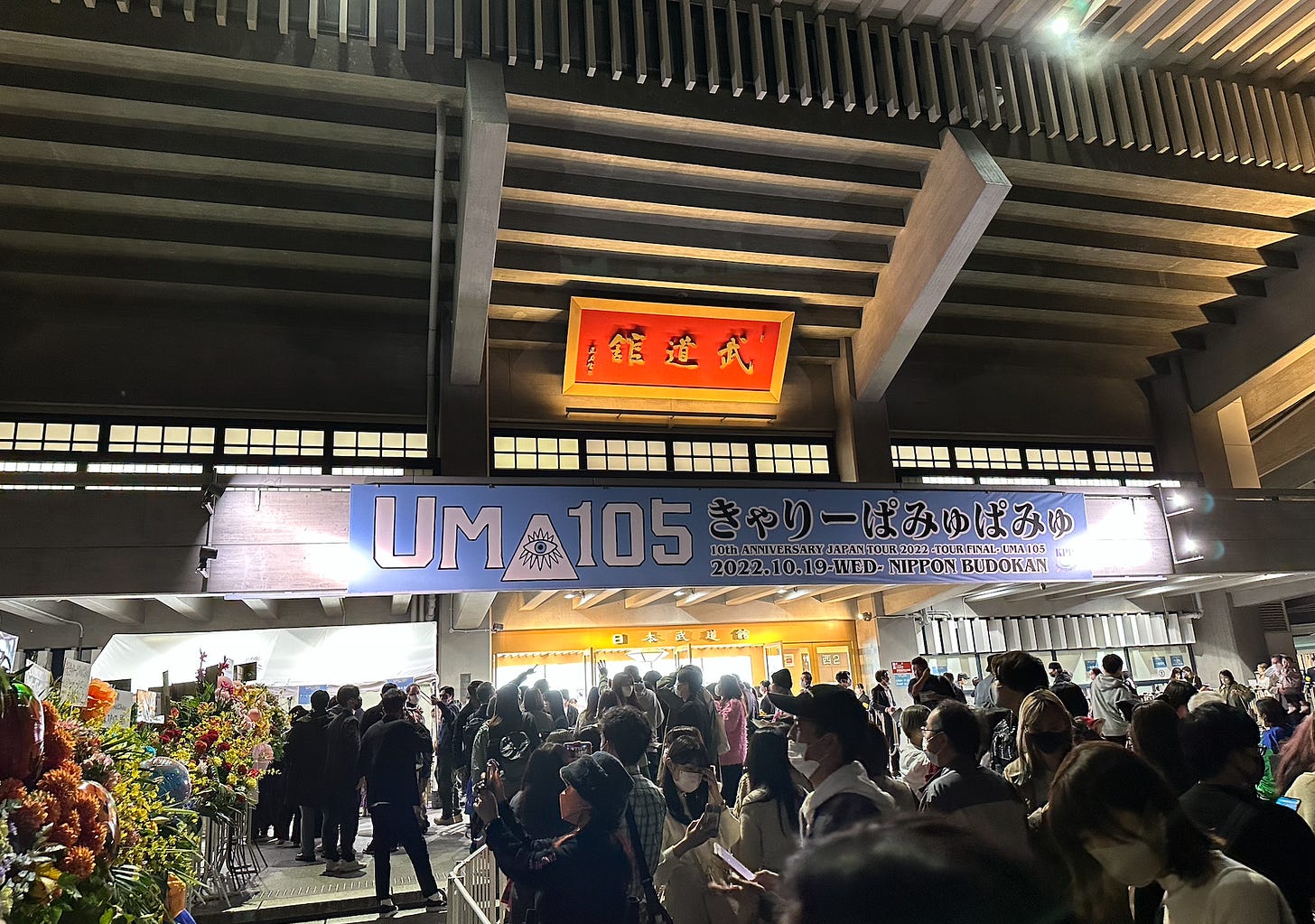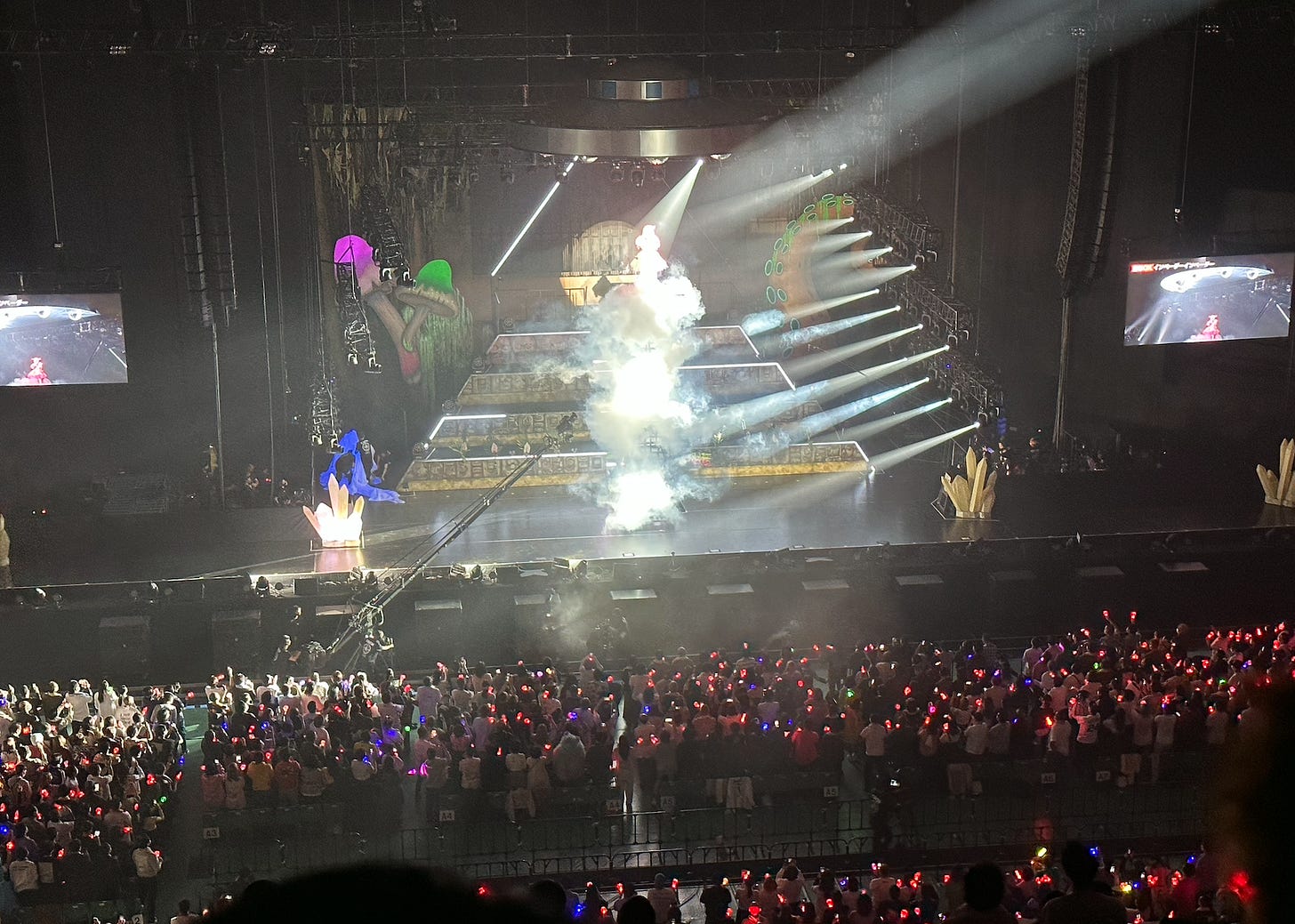Photo By The Author
Kyary Pamyu Pamyu’s 10th anniversary blowout at Nippon Budokan seemed more like an endurance challenge than chance to celebrate for the artist in the spotlight. A certain amount of reflection would be expected from an anniversary performance, but this was closer to a maximalist edition of This Is Your Life. The nearly three-hour-long show found Harajuku’s ambassador to the world running through almost literally her entire career — 63 songs, ranging from obvious bangers to C-sides created for housing companies.
Some entries were more snippets than anything else — she spent about six seconds on her cover of Capsule’s “Jelly” — but this just made me, perched up in the top row1, feel all the more exhausted for her. How do you condense a decade-spanning career that has taken you from fashion boutiques to Coachella into one evening without burning out as you race through Shibuya-kei diversions and rapped mutations on enka? One period suddenly came to a halt as she launched into another, all backed by backup dancers, some dressed as cryptological beings.
Kyary herself said as much a little over midway through, expressing her tiredness from this song sprint and holding up a water bottle near total emptiness. Forget the physical dimension, though — what’s the mental and emotional output of cramming your entire artistic existence into a stage show?2
Last round-up email, I wrote that BABYMETAL “sure felt like” the most popular J-pop act globally of the 2010s. That kicked off a little discussion about who really fits that bill, with entries all offerring their credentials.
But you know who should have been the answer? Kyary Pamyu Pamyu.
It’s easy to forget ten years on, but for a window back then, Kyary stood her own globally with any non-English-language act abroad. “PonPonPon” benefitted from the sort of “megalolz Japan be wacky!” attitudes that were ever-present in the early 2010s but totally extinct today, but that helped boost it into an honest-to-goodness virality at a time when this never happened. Superstars like Katy Perry, Ariana Grande and Lady Gaga sang her praises. An entire themed cafe enjoyed a tourist-powered stint in her stomping grounds of Harajuku thanks to her kawaii fashion sense, becoming a cornerstone of the decade’s inbound boom.
Yet watching her blaze through her own song catalog on a balmy Wednesday night in October reminded of another reasons for her essential status — no J-pop artist captured the experience of existing in 2010s Japan like Kyary. It sounds like a stretch, but I’ll back it…part of the reason she connected with domestic listeners in 2011 was becuase people desparately wanted an escape post 3/11, and this cheeseheaded-fashionista offered just the right type of Technicolor escapism in the face of a once-in-a-century natural disaster.
Go beyond that calamity, though, and you find an artist obsessed with the tightrope walk between childhood and adulthood.3 What's constantly refreshing about revisiting Kyary's music — or, you know, having it blended up into an evening set — is how wise it seems. In recent years, the spirit of J-pop has been sullen and rebellious, with YOASOBI imagining suicide pacts and Ado screaming against the world adults built. The tension of Kyary’s music, though, centers around wanting to exist in both. She’s “kawaii,” which is to say somewhat pathetic and infantile alongside more broad-stroke cute. Yet she’s constantly thought about coming-of-age moments, and spent entire songs saying goodbye to her own self. All of the “cuteness” is often undercut by true weirdness and a kind of kimo-kawaii dwelling on darker aspects of humanity. This Budokan show adopted unidentified monsters and mysteries as a theme — picture dancers dressed as the yeti, chupacabra and “Backwoods Monster” among others creeping around stage and occassionally busting moves — to offer a creepiness subverting the music.4
When I interviewed her in 2018, we spent a good chunk of time talking about “The Musuem Of Death” in Los Angeles, a space that stuck with her.
Grisly, but not totally what made her so affecting. While she dashed through the bulk of her song book at Budokan, she omitted two songs that, to me, explain her appeal better than any other. One is Nanda Collection5 closer “Otona Na Kodomo,” a house-dappled number where Kyary comes closest to offerring Cliffsnotes to her entire existence — she wants to be an adult, but be able to dip into the simplicity childhood provides sometimes. The other is from her first full-length album, and might be my favorite non-single she’s ever put out. “Drinker” is a then-teenaged Kyary fantaszing about turning 20 years old so she can…drink alchohol. Simple, but deeply sweet…being a kid is great, but being an adult and having the freedom to drink fruity booze is beautiful.
Kyary Pamyu Pamyu performing with various members of former backup dancers Tempura Kidz, photo by author
Having to watch an artist’s entire career play out at micro-dose levels forces you to remember all the weird shit said performer found themselves tangled up in. Kyary Pamyu Pamyu might have the oddest trajectory of any artist in J-pop over the last decade, at one poine an inescapable mainstream presence before…kind of flopping on the sales front and seemingly becoming an international-only Japanese act.
And yet! Remember when she dated the lead singer of Sekai No Owari and became a figure of paparazzi interest — referenced in her own music videos — before they broke up6? What about when she became political? Or how she became a spokesperson for the COVID-19 vaccine? Even as her music became less of a commercial hit at home, her presence still loomed large. Once an example of “weird Japan” ephemera, Kyary has grown into the current state any notable artist or personality finds themselves in modern time…she’s human clay, something to be molded by random netizens and users to fit whatever need they want, accurate or otherwise.
Whatever you decide she is, Kyary is important, and tells the story of J-pop in the 21st century as well as any other artist.
Kyary descending on to stage “on a cloud,” photo by author
Moment of honesty — I’ve seen Kyary Pamyu Pamyu live more than any other artist in my life. That’s entirely due to good timing — at the same time she was at her apex, I was going to festivals of all sorts for publications like MTV81 (RIP). She was always on the bill, so I caught her performances from the Pamyu Pamyu Revolution / Nanda Collection on the regular back when mega-media-corps thought covering Japanese music was a viable financial strategy.
Yet it goes deeper than that. Kyary is maybe the only top level artist whose career I’ve watched from beginning to…wherever it is at now. I remember jetting out of my junior high school teaching job in Aoyama to run over to La Foret in Harajuku to catch her free Pamyu Pamyu Revolution release show in 2012, getting into the livespace despite no clear instructions on how one gets into the event7. Around the time of the release of her third album, I went down to Kawasaki in Kanagawa Prefecture to buy a handshake ticket to literally say "thanks!" to a J-pop star for a split second...the only time I've ever done that. A large chunk of my writing career can be thanked to a disgruntled Tumblr post I wrote about Pitchfork's (very bad) review of Nanda Collection, which I responded to hours after watching Kyary perform at Rock In Japan8. I basically travelled to New York to see her. I've interviewed her several times, including one instance focused around Italian food.
The doria is good!
This is to say…Kyary’s musical career nearly matches my time spent living in Japan. To watch her race through her own pop history was to also reflect on a period of my life. Perhaps a little dramatic, but that’s the thrill of music, right? The way someone else’s art can so easily imprint onto our own existence, even if they are singing about pumpkins.
By the end of the night, Kyary herself was overwhelmed by the moment, and I saw something I’ve never seen before…she cried, thanking those helping make this show happen and everyone in attendance. After seemingly racing through her pop life for most of the night, she slowed down, and soaked it all in. It was that breathing room — and the tears that followed — that justified the madcap pace before it.
Closing song of the night
Written by Patrick St. Michel (patrickstmichel@gmail.com)
Twitter — @mbmelodies
Follow the Best of 2022 Spotify Playlist Here!
invited by her current label Nippon Columbia, lovely folks, full disclosure
Though also…this was the conclusion to a postponed tour to her last album, and the new songs (“Candy Racer” and “Dodonpa,” the latter featuring her truly scatting on stage) stood up with nearly everything from her past, what a set!
That the show leaned into cult-like imagery — pyarmids with eyeballs in them — became a thousand times more unintentionally bewildering / hilarious after the show, when I realized…holy shit, I watched a chupacabra man breakdance on the very stage they held Shinzo Abe’s state funeral on.
Let’s also not discount this…Pamyu Pamyu Revolution and Nanda Collection are also absoulte classic albums, even if you listen to them unaware of Kyary’s own struggle between innocence and adulthood. Yasutaka Nakata was on one during this stretch.
It appears to have vanished from the internet, but part of this involved Fukases of Sekai No Owari posting a doofy code about Kyary, total tweenage antics. Trust me on this, also what a dweeb.
I absolutely was let in because I wasn’t Japanese…the only non-Japanese person in attendance, absoutely batshit in retrospect. Others had special invitations!
Thanks eternally to David Turner of Penny Fractions for encouraging me to actually email Pitchfork…which lead to actual chances to write for the site.










Thanks for sharing such a personal and heartfelt reflection here, Patrick. I really appreciated reading your perspective.